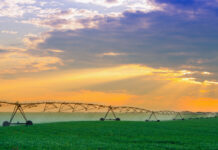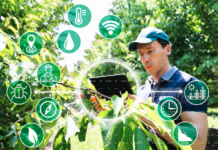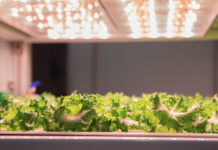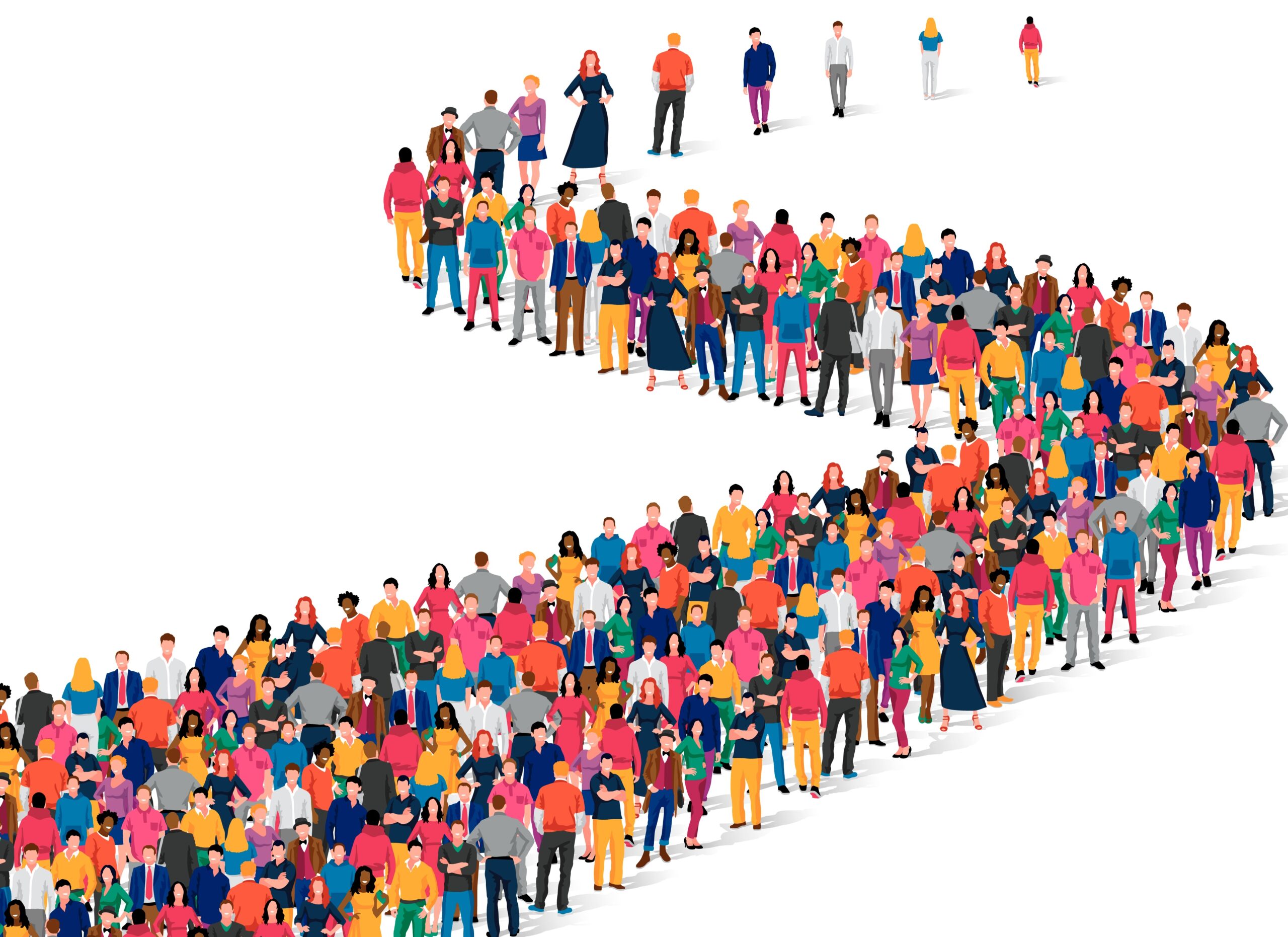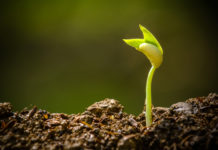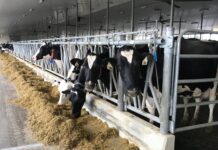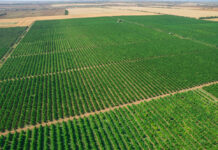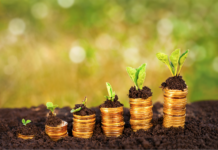[Music fades up, sounds of farm animals, tractors, computer clicks and digital noise]
Hannah Senior: Agriculture is one of humanity’s crowning achievements. The ability to feed ourselves via a network of global national and local food systems is genuinely amazing. Agriculture is a foundational block critical to our success as a civilization. But at this point in our shared history, that foundational block is looking unsound. Economic imbalances, labor shortages, and the huge environmental impacts of agriculture have led us down a path that is seriously unsustainable. Something has to change. And introducing new technology to agriculture might just help us steer away from the bleak future that we’re otherwise all staring at.
This podcast series set out to investigate how the world of agricultural technology entrepreneurship can help. We started by asking why we even need new technology, which led us to the complex issues facing the food system, including labor shortages, lack of farmer profitability, and the huge environmental toll modern agriculture takes on the planet. We’ve dived into why entrepreneurs are important to help drive change, and explored how to best support emerging AgTech solutions.
We spoke to farmers about how they engage with AgTech startups, including the risks and challenges they face when it comes to trialing and adoption, as well as talking to AgTech entrepreneurs about their experiences starting a business in the world of agriculture, and all the opportunities and challenges that come with that. In the last episode, we looked at alternative models for investing in AgTech startups, and how a particular template of investing, which accompanies a particular style of entrepreneurship, has ingrained itself into our way of thinking. But perhaps our whole model of thinking about enterprise and business is itself built on assumptions that we should be questioning.
In this episode, I’ll be exploring some assumptions about how the world works that are so implicit in my Western Anglo Saxon industrialized view of things, but it didn’t occur to me to recognize how they shaped my thinking. I’ll explore how this might be hindering our best intentions with our technology, our ventures and our farming systems.
[Music fades in and out. A tractor drives by]
Hannah Senior: There’s an interesting book by Charles C Mann called The Wizard and The Prophet that contrasts two perspectives on how we’ll save humanity from itself. The Wizard of the book is Norman Borlaug, the father of the Green Revolution, whose use of science and technology brought advances in plant breeding in the last century that saved hundreds of millions of people from starvation. The prophet is William Vogt, an intellectual father of the environmental movement, who saw that humanity’s excesses would damage nature so thoroughly, that it would cause ruin for us as a species and the planet as a whole.
I mentioned this, because these two perspectives still echo today. They’re still present, and often still shouting at each other. Personally, I don’t think it’s helpful to set the two perspectives at odds. And although I tend towards the technology end of the continuum, I’m quite clear that neither in its purest form is right. Why? At the start of the series, we explored the hope that new technologies would help us to reduce the environmental impact of agriculture, as well as help improve worker conditions and the way that profit is shared throughout the value chain. Even at that point, it was clear that technology wouldn’t be the only thing we need to make a difference.
Let’s revisit this conversation asking what problems technology is well suited to solving? And what are the tools we might need? AgTech investor and entrepreneur Peter Herz broke it down really well:
Peter Herz: You know, maybe this isn’t good news, but pretty much almost every corner of the food system is broken. Everyone has been trained, I have as an engineer, and most other disciplines have been trained in a methodology called Reductionism, which tries to break things down into bite size chunks that people can study, work on and solve for. And
unfortunately, there are systems and classes of problems that will not yield to that methodology.
Biological systems and human systems do not serve – do not get addressed – by the conventional methods to try to deliver solutions for. Engineering is perfectly suited to solve information problems. You’re bringing the right tools to the party. We don’t believe reductionism is a good methodology to develop solutions around food or biological systems, because if you don’t understand the operation of the natural system, it’s very unlikely – as in a mere zero probability – that you can create something artificial that will somehow magically not create issues in the natural system that you didn’t understand in the first place.
That has not stopped many people from trying to do precisely that. And unfortunately, they can sometimes turn into very bad ideas. And one example of that is in the 1950s, we invented trans fats in the lab. And we decided that everyone in the 60s and 70s, primarily, should stop eating butter, butter would kill you, you absolutely cannot eat butter, everyone should eat margarine. And so we went down the margarine road and other highly processed foods. But you know, it took us 50 years to discover this, or at least to act on it, we actually discovered it quite a long time ago, that trans fats kill people. And maybe we should ban trans fats from the food supply. Well, that was a half century of a really dumb path. And we seem to take every new innovation that shows up, like it’s going to completely solve the problems that we’ve identified. And we don’t take a look at it, I think through a critical enough lens. And our history supports this view. And I believe the reason that processed foods are not good for us is because of this reductionist methodology, the engineering method, the scientific method that we use, does not get us to good conclusions. And we really don’t understand how these systems work. And if you don’t understand how the systems work, you cannot create some synthetic replacement for what the natural system does.
Hannah Senior: A sense that we can’t rely on technology alone to dig us out of the hole was echoed by Brent Loken, of the WWF, when I asked him whether we knew what we had to do to address the food systems impact on the environment.
Brent Loken: Yeah, I would say that at the global level, we have a pretty good sense of what needs to be done. You know, what we have to do. At the national level, we have much less sense of what needs to be done. It’s much murkier, at the national level. On individual farms, I would say that farmers often have a lot of wisdom and knowledge in terms of: they know the land, they’ve been working in the land for a long time. But what what we don’t need though, we don’t need to kick the can down the road and say “we just have to rely on technologies, we just have to rely on some invention of something that’s going to come in and save us and reduce, you know, methane emissions, or make farming practices all the more environmentally friendly, because we know what exactly we have to do”. We have the practices in hand, it’s more just creating the conditions and allowing them to happen.
Hannah Senior: What both of these people are getting at is that we can’t reduce environmental damage or economic inequality that’s a feature of contemporary agriculture, with individual technical solutions alone. So going back to that book, technology was what Norman Borlaug focused on, he wanted to reduce starvation, so his solution was to breed wheat that produced more yield, and relied heavily on synthetic fertilizer and bio controls. It was an amazing achievement, and it stopped probably more than a billion of our fellow humans from dying of starvation. But it created new problems with environmental havoc of runoff and biodiversity loss. And yet, would William Vogt’s solution have helped us anymore? He is right of course, that we could stop despoiling our planet by eating less with less choice, more starvation, and by dying a lot sooner. I’m just not sure that would go down too well with the voters.
We need to start from where we are and find a more practical solution. We need to find a method of thinking about how a decision here affects an outcome there. How increasing the way we do X influences a seemingly unconnected factor Y? In short, we need systems thinking. Both biological and economic systems are at play when it comes to AgTech entrepreneurship. And without thinking about the systems we’re operating within, our efforts or new technologies might ultimately either backfire, or undermine our intentions. This is what systems thinking is all about.
[Music fades in and out]
Hannah Senior: What is a system? What is system thinking? And what is the food system? This was a theme that came up over and over again in the conversations I’ve had, and gradually, it opened my mind to the importance of this perspective. In the first episode, Brent Logan explained to me what the food system is, here’s a quick reminder.
Brent Loken: Yeah, so a food system is everything that we do to get the food from the farm, to the fork, so the food that we eat. So it’s everything from how we produce food, and the environmental consequences of that, how we actually transport food to get it from where it’s produced, all the processing that goes into the food, and then the waste.
So if we throw food away, throw it into the garbage, it goes into the waste dump. So it’s all of those systems and processes that we put into this complex web of activities that we call the “food system”. There is one global food system, which has this interconnected, local and regional food system. So there’s, you know, food systems everywhere, there’s food systems, and you know, backyards, there’s food systems within cities. But when you add up all those collective activities, you’ve got the global food system, and the impact that that has.
Hannah Senior: Ben Honan of Amsterdam’s Climate KIC, who I spoke to in Episode 5, also gave me food for thought on systems thinking.
Ben Honan: We’ve known about emissions and the warming effect of carbon dioxide for 60 years now, since 1960 it’s a published Scientific Fact. And in the 70s, and 80s, there were global treaties, very similar to the Paris agreement, to take ambitious climate action. And then you roll forward 60 years, and here we are in 2021, with absolutely no emission reduction in any meaningful aspect of any corner of the globe.
So you start to think well, do our traditional ways of thinking about how to solve a problem, which, while very heavily on engineering and mathematical principles, do they work? No. We need a different approach, which lends a bit more on natural sciences, and thinking about ecosystems and system thinking, which is looking at how different feedback loops interact with
one another and how these platforms and connection points are more important than the individual decisions or individual actors in the system.
So you start to think more about the relationships and dynamics between things, and how one thing can influence another and cause a kind of cascade effect. So that’s not the only way to think, it’s just one way to think but it does help you think about things from a different angle. And instead, if you’re thinking about it through a systems lens, you should be able to spot some of those problems earlier, and make smarter decisions along the way. And hopefully, then, the idea is it leads to a better decision at the end of the day
Hannah Senior: I set out with questions about how we could make our AgTech entrepreneurial ecosystem more vibrant, and how we could better align the interests of the environment, entrepreneur, farmer and investor. But when we put a system lens on these questions, it’s clear that they don’t sit in isolation from a whole load of much wider questions. Daniel Zimmer is the director of sustainable land use at Climate KIC. When I spoke to him, he summed it up really well:
Daniel Zimmer: We are convinced that you cannot transform the way we produce, the way we consume, in taking a sort of piecemeal approach and addressing successively and small issues. We need to have a holistic or all encompassing approach, because transforming the way we consume produce is not something that is easy. Just take the example, for instance of the electric car transformation, you cannot just produce electric cars, you need to ensure that there is training for those who will be servicing these cars that have charging stations, but also that maybe the subsidies and the support from the government are targeted in the right way. So you really need a completely holistic approach. And it’s the same for food, for farming practices.
Hannah Senior: Right back at the beginning of the series, I mentioned Donella Meadows, the late great author of a brilliant and rightly famous book about systems thinking. She describes the system as “an interconnected set of elements that is coherently organized in a way that achieves something.” She goes on to write “to ask whether elements, interconnections or
purposes are most important in a system is to ask an unsystematic question. All are essential, all interact, all have their roles. But the least obvious part of the system, its function or purpose, is often the most crucial determinant of the system’s behavior.”
The purpose of our food system is to ensure that everyone has enough to eat. But it is more than that. Most of the actors in the food system, and in agricultural technology, are businesses. If the food system’s behavior isn’t doing great things for our planet, or for easily exploited workers or for farmers, perhaps we need to look at the economic system that’s underpinning all this. Maybe it’s because that’s how we’ve set up our economy. In Episode 2 and 5, we discussed at length a particular model of startup entrepreneurship, the Silicon Valley model, and the traditional VC model of investing in these companies. It’s a method designed primarily to generate wealth for investors and for successful entrepreneurs. And the pursuit of wealth underpins how we’ve set up our economy and society.
We tend to see wealth as a powerful indicator of success, and it generates improved social status, two big reasons why getting rich is so often prioritized. The problem is that our economy is not set up to take into account other considerations: environmental impact or effect on consumer, worker, or animal health and well being. These are what economists call externalities, defined as “a consequence of an industrial or commercial activity, which affects other parties without this being reflected in market prices”. So perhaps we need to understand the economic thinking underlying all this.
[Music fades up. Sounds of farm animals]
Hannah Senior: I find business really interesting. Economics, however, was not my favorite subject. Sometimes called the “dismal science”, my sense has been that “dismal” fits, although personally, I never found it very scientific. It didn’t seem to take into account the available evidence very well. And yet my interest has been sparked recently by a number of economists and thinkers starting to articulate gaps and inconsistencies in the discipline’s intellectual foundations, challenging some of the implicit assumptions.
With these revisions, the discipline is much less self assured, but much more attuned to the world we experience around us. Kate Raworth is the author of the 2017 book Doughnut Economics, the doughnut refers to a way of characterizing her ideal that we should ensure humanity does not fall into the center of the doughnut, experiencing shortages of the essentials of life, but also that we do not exceed the outer edge by exceeding the planet’s capacity to provide.
By this measure, we’re not doing so well, nationally or globally. We simultaneously have many falling below the bare minimum social foundations, such as having clean water or basic rights, while also exceeding the planet’s ecological ceiling, such as climate change, biodiversity loss, and ocean pollution. Three aspects of her argument are really interesting in the context of this investigation. First, she challenges the mental model used in economic thinking, the “rational economic man.” Raworth points out that humans are not always rational. We all have well known psychological biases, and are prone to irrational behavior. We’re also not solely concerned about economics or money. We want relationships, beauty, nature, all things that are not easy to put a financial value on. Finally, we’re not all men.
In the 21st century, the rational economic woman might have something different to say. When you point these things out, you’re bound to ask what happens to the model, when the actor in all the assumptions is seriously over simplified on many levels.
Second, Raworth questions the pursuit of economic growth as the objective of an economy. We’re all so familiar with the chart that rises upwards to the right, the news commentary on the latest GDP figures. I’ve never stopped to ask myself whether it’s realistic. When you think of it, nothing in the universe grows forever. But what are the implications of building our economic assumptions on the idea that year after year, generation after generation will make more money to buy more stuff made by extracting more raw materials? Are we walking into a fairly obvious mistake? And if we begin to question this assumption, what should our goal be instead?
Third, she insists that social, environmental and economic parameters are intimately linked, and then using a systems mentality is essential to think about how they interact. If we pursue an economic model that doesn’t price in the environmental and social costs of the products and services produced, or an environmental intervention, which is indifferent to how it affects people or businesses, or a humanitarian intervention, which is heedless of its financial or ecological cost – all of these are inevitably going to have undesirable consequences.
Why does this matter? Because it highlights the forces our economic system builds in, and how the primacy of financial wealth, the pursuit of growth, and a tendency not to recognize that complex web of relationships, constantly pulls us back to business as usual. Most of the time, we’re obliged to go with or we unthinkingly default to the choices that have the lowest risk and the highest or best chance of financial return. This goes for probably most of our business decisions, regardless of who benefits from that return, and what other implications might be.
For example, a farmer might want to adopt more sustainable practices. But if their customer won’t pay more for the end product, the business may not be able to support the extra cost. Entrepreneurs need to get traction and are obliged to make compromises to do this, such as focusing on markets with a quickest short term payback, even if the need there isn’t the greatest. And investors need to grow the money they’re entrusted with. They are typically obliged to maximize the financial performance for capital they invest in the way they promised, even if that means a very narrow focus on what they invest in, and how.
Let me be crystal clear. I am not for a moment suggesting that we should abandon capitalism or profit or saving and investing for our futures. The discipline of the market is a critical tool to weed out free riders, influence how capital is allocated- it may even be our best tool to identify the Vblenian entrepreneurs we met in Episode 2. There is no doubt in my mind that a successful business venture is one that profitably meets the needs of customers, providing needed products and services, while generating the financial autonomy to reinvest and create financial stability.
As result of this project, I began to realize that we might have taken too much of one ingredient of the economic doctrine; and it’s poisoning us. Just because something is good for you, it doesn’t mean that more of it is necessarily better. When the focus gets turned into the pursuit of financial performance and growth at all levels, prioritizing our own immediate self interest, it becomes too much of a good thing. It’s the dose that makes the poison.
Asking how we can reshape our economic system goes way beyond the scope of this project, but it’s important to recognize and question the influence that this has on behavior in our economic system. This focus pulls our best intentions for change back to business as usual, when we’re faced with harsh economic reality. If we accept, for a while, that our economic and social systems have a tendency to pull organizations towards doing what’s low risk and financially required – even if that works against people and planet, we should ask ourselves what we can do to resist or temper this tendency.
In the conversations I had, many of my interviewees talked about this topic. Sarah Mock noted that investors seeking returns turned to AgTech after Monsanto purchased Climate Corp. But, she argues, the desire to do good by the environment has faded faster for the investors and entrepreneurs than their desire to make money.
Sarah Mock: In 2008 or so we were really excited about green tech, believed that green tech was going to be this huge thing! We’re all gonna invest in solar panels and electric cars and investing in that was gonna make everyone rich and the world a great place. And we figured it out. And then there were some big not-great things happen in green tech around solar and a couple of other things. And a lot of that money kind of looked around and said “like, okay, there’s other ways to do green that aren’t green, per se.” And I think a lot of that money came to agriculture, obviously, specifically with an interest in making money but secondarily, with a real eye to “how are we going to use these technologies to achieve ‘green goals’?”
I think, at first, we were really into precision agriculture, and that was the main focus. It was all about reducing fertilizer use, reducing pesticide use, reducing water use, you know, even there was kind of the that future vision world of “you’re going to have individual robots that provide
individually tailored quantities of water and nutrients to each individual plant and that there was going to be zero waste in the system and it was all going to be about efficiency.”
I think AgTech has really moved away from the ideas of hyper efficiency. AgTech is about tying agriculture to environmental outcomes. In its DNA, AgTech is about making the world a better place and improving agriculture. I think it’s really lost that “heart” of doing things like improving things for the environment. I think there’s a little bit of that, as far as it helps achieve the goal of improving agriculture. But I think in general, the technologies that are still around that kind of survived that first flood – and then the five years that followed – are the companies that have set their environmental goals aside, and have focused on creating maximum returns and helping farmers or, I don’t know, listening to farmers where they are. Until, like, 18 months ago, the general consensus from most farmers in America was that climate change didn’t exist. So, I think AgTech listened to their customers and kind of got on board with that for a while.
Hannah Senior: Ben Honan also describes these pressures well. We were talking about why it’s so hard to change the fish farming industry from relying on soy, which is most certainly not a source of nutrition fish evolved to rely on, towards something a bit closer, like insects.
Ben Honan: This is where system thinking comes in a little bit, because you say “well, why? It’s an easy decision to make?” Well, not really, because whoever’s making that decision is subject to a whole system around KPIs and career performance and assumptions from their boards and you know, presumed performance. And there’s a lot of the social norms, that anti risk taking in that environment.
So then you need an intervention to help you take the risk that from outside looks perfectly sensible thing to do. But when you’re sitting there in the system, and you’re subjected to all these influences, is a little bit uncomfortable.
Hannah Senior: Having a clearly defined mission is one way that organizations set a direction, and help to ensure that the cumulative effect of smaller organizational decisions don’t add up to moving off course. Bethany Deshpande, one of the entrepreneurs we heard from in Episode 4, behind the Canadian company, SomaDetect, spoke about how putting their mission
statement first and foremost, helps them navigate finding the right investors and standing firm when being pushed in certain directions.
Bethany Deshpande: The first startup accelerator that we did was a more general, but social impact or social innovation accelerator. And as part of that accelerator created, very intentionally, like the mission, the vision and a series of impact statements. And our impact statements are “better data for farmers, better milk for consumers, and better lives for cows”. And that’s been something that’s been a really powerful kind of battle cry for our company, and something that farmers investors, lots of folks are excited to get behind. And I think having those things set from the very beginning: mission, vision, the impact that you want to have in the world, has been enormously helpful for us, really impactful in terms of really attracting the right people, both internally into the company and at the team level. And with regards to investment.
Certainly, we’ve had investors who want us to go faster. And I think, if anything, you know, with our mission with our vision and values and impact statements, and then that level of clarity has helped investors get behind us and say, you know, “we have had folks that have said ‘go faster’, go faster”. And then when we say, “well, but here’s the situation, you know, here’s what we’re actually doing. And here’s our intention at getting to that speed eventually”, then they’re actually – they’ve been quite open to or sort of understanding of that, I think.
Hannah Senior: One of the ways in which this balance of incentives and motivations is managed and commitment to mission is maintained, is through governance. Like economics, this is a topic I had lukewarm enthusiasm for prior to this project. But I’ve warmed up to the concept now, recognizing that it’s a really important tool to ensure that broader goals are taken into account in a startup environment, especially that a sense of mission is not sidelined by the primacy of financial returns for investors and the norms of how our organizations are run. SheEO’s founder, Vicki Saunders, weighed in on governance when we spoke.
Vicki Saunders: It’s kind of interesting. Governance is challenging, because governance is set up and regulations are set up for a certain reason. But an example around this for financial governance: we do 0% interest loans, which prior to COVID, were not a thing.
Everything has some interest rate attached to it and some success rate. And we also don’t care, really, if your loan is paid back in five years. If you need a bit of extra time, that’s fine. We have a radically generous point of view on these things. So when we get audited each year, they ask us “which loans do you want to write down?” I’m like, “we’re not doing that” and they’re like “Oh yeah, you have to”. So they go through this massive process – because of the way accounting is set up – to look at what is the value of each loan, whatever. And we do this whole huge, “activity”, which is a total waste of time in order to fit into this model, because of the way regulations are.
So governance is a fascinating thing that we talk about all the time. But it’s really based on control versus trust, and control’s really expensive. So we constantly have a bit of a dance between this control / trust, what do we need to be careful of? Risk? What does risk look like? Reputation risk in a trust based environment -how do you think about that? It’s very different.
Hannah Senior: This question of trust, it’s picked up by the observations of Daniel Zimmer, too. He is the Director of Sustainable Land Use at Climate KIC. He described three characteristics as being critical for any system wide change: trust, risk and value creation.
Daniel Zimmer: We have learned in our project in Africa, that these three aspects: value, risk and trust are really the basis of creation of a transformative ecosystem. It came, really, from first observation, that is that in finance, most of the de-risking instruments relate only to finance. Whereas, when you transform a system, the risk is everywhere; you introduce new practices, so the farmers are not yet accustomed to the implementation of these practices, but then you create new relationships between different actors in the value chains. And so, there are risks for everyone.
Suddenly it became very clear, first that we needed to, of course, create more value through the transformation that we were trying to obtain. And then to ensure that the transformation
was feasible. It was very important to address all the risk of the farmers, of the banks of the insurers, of the offtakers. And if we are not able to look at the risks of all actors in a holistic way, we will not succeed because what we observed is that risks are automatically transferred between actors in value chains.
If one actor is facing a risk, it’s a risk also for the others. And then it became also very clear that we needed to create trust in the ecosystems that we were building and trust comes with transparency, creating contractual mechanisms, having more traceability etc.
So, these three aspects, they became progressively really three critical aspects. And we have not only validated this in Africa, but subsequently in our other projects, where we observed that these three things are extremely important for transformation in the carbon farming activities.
I have been working with this with the World Bank, who have decided to screen their projects, according to this framework, these three things and at the moment, I’m reading a number of reports that they’ve been doing, using this framework to understand whether the project had been successful or not, and whether this could explain some of the difficulties that they experienced in their project.
So I’m more and more convinced that this is a real, very interesting framework to look at the transformation and ensure that we mobilize actors in the right way to induce the transformations.
Hannah Senior: In short, for a systems transformation to work, Daniel suggests, first enough value must be generated to make it worth engaging, then risks of change need to be understood and shared in an acceptable way so they don’t become a barrier. Lastly, there has to be enough trust that everyone will do what they say, so that the value can materialize and the risks really are shared.
Daniel Zimmer: I’m, at the moment, working in greater detail on the risk part because I’m so convinced that this risk dimension has been too much neglected, there are, in fact, you need not only to ensure that risks are understood and shared but you need also to let people take
risks. So, give them enough confidence that they can take the risk. So they need to understand the risk, but understand also that their risk will be properly taken care of.
Hannah Senior: Governance frameworks, like BCorp certification, are developing to help support the balancing of different priorities in an organization. These include: balancing the financial with other goals, such as people and planet, value creation alongside risk and trust, or competition versus collaboration.
The balance of competition versus collaboration is another culturally driven influence on how we do business that bears more thought. In Episode 5, we heard from Vicki Saunders describing the benefit of a collaborative approach and the value that community support brings for startups. Both collaboration and competition are important in a vibrant AgTech ecosystem, a theme also explored by Daniel.
Daniel Zimmer: Yeah, I think that this polarity between cooperation and competition is present in our societies. And we are not conscious of how important this polarity is. Culturally, certain countries privilege a lot the competition, they feel that if you compete, the best will basically survive and spread their ideas. In other countries, the competition dimension is less important. And so cooperation is privileged. But there is always a mix of the two. And it’s important to always look at this polarity and try to see in a given context, what is likely to be more successful.
Should we create, for instance – the startup world is a highly competitive world, it’s only the best will succeed, we know it very well. But when you start working with farmers in the landscape, or with different stakeholders in landscapes, you also need to to create cooperation, because scale is very important.
If only one farmer is doing something, you’re almost sure that you will not transform the entire system. And it’s interesting because it boils down again to these two aspects of “value and risk”. “Risk”, really, is something that needs a lot of cooperation. “Value” probably needs, too, but much less. And we see that it’s also much more difficult to share value within systems than to share risks, because risk automatically transfers and spreads across the actors. Value is not
the same. So there is much more competition when you talk about value, and much more cooperation when you talk about risk. So in my view: in systems, it’s very interesting and important to have this polarity in your mind when you look at things because this polarity is important to understand the transformative actions that you can take.
Hannah Senior: Let’s take stock of what we’ve just heard. Systems thinking can help us in at least three ways: to identify opportunities for leverage to make change, to understand collateral impacts of decisions and actions, and to help us understand how the various forces can deflect us from our stated goals. But systems thinking, or any thinking, doesn’t happen in a vacuum. As we’ve just heard, it happens in the context of our culture.
We have lots of cultural and structural biases that result in prioritizing certain outcomes. Lots of models about how the world works we’ve adopted without necessarily questioning them. But not all people see the world working in the same way. Not all cultures are the same. In the two countries. I’ve lived and worked in, the UK and the US, there’s a premium on competition in business culture. Competition can drive innovation and create a hunger to succeed. It’s not a dirty word. It’s really important. And yet many, perhaps most, of the problems that agriculture faces cannot be solved by single entities operating alone. Agriculture and research, like society as a whole, has become incredibly siloed. This emphasis on competition and deep silos creates a serious Achilles heel.
[Music fades in and out. A tractor drives by]
Hannah Senior: One organization I spoke to that recognizes the importance of collaboration, and has had a big impact on how the agricultural sector operates in New Zealand, is TeHono. I spoke to the General Manager, Kimberly Ansell, to find out more:
Kimberley Ansell: TeHono means “to connect” in the indigenous language for Maori people of New Zealand, so TeHono really is an organisation charged with transforming the New Zealand primary sector or agricultural sector from what we like to call “volume” to “value” or more recently, we’ve been saying “volume to values”. And that’s where we’re trying to really create a future focused sector that’s primarily moving away from a commodity paradigm, which we have
been built off of over 100 years, and how we trade with the world – but actually becoming much more closely aligned with what our consumers want and need.
Hannah Senior: The heart of the organization’s work is to take CEOs from established industry leaders, and the civil service, all focused on primary industries, and bring them together in a boot camp at Stanford University; a week-long immersion in new ideas and inspiring businesses.
Kimberley Ansell: TeHono was founded on our founding principles, and that’s around trust capability and action. So we’re really looking at building trust, we find that trust is something you got to keep working on in the very first program, and it still happens now. You’ll have people in the room who are competitors, and have a history and perhaps don’t like each other very much. But generally, by the end of an intensive program up at Stanford, they’re usually much more comfortable having a glass of wine or beer, talking about the challenges, talking about the pre-competitive stuff – that maybe they’re accessing similar markets, or they’re having trouble with export rules or regulations, you know? There’s certain stuff that they can still connect on. And that piece is really important.
So trust building relationships are hugely important. The next one is capability. So we want to really keep on “the edge”, keep connecting with the world’s global thought leaders, business leaders, and helping our business leaders understand what is happening around the world, so that they can also be the best.
And then more recently, in the last kind of maybe four years, we added on to our foundation pillars, “action”. We’ve got a dotted line to action, because at TeHono, we bring people together and we show them what we think might be opportunities or challenges coming up. But ultimately, it’s up to those people that are on the program to then go forth and make change. And that’s why we always incorporate a component in our programs to force people to stand up and commit to what the changes or are the next steps are going to be.
Hannah Senior: One of the striking concepts in the way TeHono operates is that it brings together commercial leaders immersed in commercial imperatives and the need to compete.
But the culture and orientation of the organization encourages the thinking to be more holistically oriented.
Kimberley Ansell: There was always an environmental piece at TeHono. There was a real realization that we were losing our social license to operate that, you know, consumers were demanding different things from our environmental impact, and animal welfare. And I think that’s always been there. What was kind of beautiful in that second boot camp program where we brought up the Maori leaders – they really added the layer of how connected they are as individuals and as a peoples to the land and water, the air, and aligns really closely to a few.
If you harm the land, you’re harming the people. So adding onto their multi world view into the program really created a richness in a deeper understanding around what makes New Zealand different and actually how can we be the best in the world and it’s really anchoring off those pieces.
Hannah Senior: This is another theme that came up in several different interviews, and which I haven’t really anticipated. My culture’s Western-Anglo-Saxon-Judeo-Christian mindset about business and the use of the land is not the only way of seeing things. Indeed, there’s a great deal to be learned from other indigenous cultures when it comes to recognizing the environmental and social impact of agriculture. Brent Loken referred to this when I asked him how good our understanding is about what needs to be done to reduce agriculture’s impact on the environment.
Brent Loken: A lot of indigenous people especially have been farming in an environmentally friendly way for a really long time. So that knowledge is actually there, right? That knowledge exists, what we need to do is we need to start connecting the dots between some of those knowledge systems – but it’s going to be very hard for farmers to automatically change to a different type of farming system or do some intercropping, or put some trees on their lands, which they might want to do anyway, without some support from the government or without some kind of outside support to be able to enable the conditions for that to actually happen. So I think, you know, the knowledge is there, it’s in pieces at the global level, it exists. In some
places in pockets at the local level, it exists at the national level, I think it’s a bit darker, murkier. But now it’s our job to start bringing all you know all of that together.
Hannah Senior: What he’s pointing out here is that other cultures have done a much better job of feeding themselves, while also looking after the planet. And we really could do to learn from this. It also came up when Vicki Saunders was talking about different ways of thinking about investment, and the economic system.
Vicki Saunders: Our community has been learning a lot from indigenous cultures that came before us that have very, very different philosophies around economy. And their collective economy process talks about “increase”, not about “growth”. And so: increase in connectedness, increase in health, increase in collective wealth and wellbeing. And so I think a lot more around “increase”: what are all those other benefits besides just the financial return piece of growth? We are living in a world where in our economic models, the economist in the early days, just removed all that stuff and said, “Oh, that’s an externality. Doesn’t matter”. So we don’t have an economic model that makes any sense at all. It’s not rooted in any real reality. And we have so much evidence of that right now. And if we did actually look at this, from a “full picture” perspective – this is something I read as a study on this a few years ago – there isn’t a single sector, no one on the planet that would be profitable, if you included the environmental and social costs. Not one. So we do not have a model that can get us to being more in harmony with the biosphere we’re living in.
Hannah Senior: The last few 100 years has made many humans’ lives much better. There is less hunger, more access to medicine, greater life expectancy. Much of humanity has heating and education and travel and universal suffrage and many more wonderful things that a few 100 years ago would have been unimaginable. And yet, we’re recognizing that there is a price to pay.
There are drawbacks to the prevailing way of doing things. We’ve achieved this miraculous transformation with the mindset and attitudes that have left a mixed bag legacy. Colonization, the reductionist method of problem solving, the idea of dominion over the earth, rational
economic man. These ideas and their impacts are things that we in the Western rich world carry around with us, and we scarcely recognize it. Reminding ourselves that this is not the only view of the world, is useful.
We really can learn a lot by seeking out perspectives that prevailing Western culture has historically marginalized. Having the humility to acknowledge and explore alternative perspectives is important. Arguably, what we explored earlier about systems thinking is simply tapping into a long tradition that many communities around the globe have had; of recognizing that everything is interconnected.
[Music fades in and out]
Hannah Senior: As we’re getting towards the end of this investigation, it’s time to take a step back and think about this in the round. I set out to explore how we create a more vibrant AgTech entrepreneurial ecosystem, and how we can better align the interests of the environment, farmers, entrepreneurs and investors. Thinking back over the conversations I’ve had and the ideas that have been shared, a picture is emerging, which is both unsettling and encouraging.
In Episode 1, and two, we explored all the ways in which feeding humanity, agriculture, extracts from the environment, and often from the poorest and least empowered people in the world. I laid out a case that technology, innovation and entrepreneurship are important tools to change this dynamic. But this sits within a wider picture, which includes the need for farmers to find new ways to capture a greater share of the value that the food system creates.
In Episode 3, we explored how innovators work with the agricultural community, arguing that the farmers and growers providing insight and expertise to startups should be doing it in partnership with adequate compensation for the risk, time and effort involved. Many farmers have had their fingers burned by the cost of engaging or by raised expectations of an innovation not being met. I asked whether we need to rethink how this relationship works, and what ideas we can borrow from those innovators and pioneers bringing farmers more fully into the picture.
In Episode 4, we talked about the experience of entrepreneurs. But just as we don’t hear from footballers who failed to make the Premier League, our tendency to focus on the successes can mean that we overlook how entrepreneurs’ time and energies are given at really high personal and financial risk.
There are lots of motivations for being an entrepreneur, some highly mission driven, some highly commercial, and some rather spurious. But once a step is taken on an entrepreneurial path, one particular model of entrepreneurship, emerging from the tech world and Silicon Valley tends to dominate our thinking. This only suits the motivations and characteristics of a small proportion of startups and entrepreneurs, and risks marginalizing a lot of ventures that could have an important impact, particularly on agriculture.
In Episode 5, we discussed how methods of financing have major implications for how a venture behaves. In large part, our models of investing in startups are dominated by venture capital, which evolved with that Silicon Valley version of entrepreneurship. We talked about prominent areas of mismatch between the needs of the VC business model, and those of many agricultural technology companies, and then explored some alternative methods for financing businesses, which might be more appropriate for emerging AgTech companies – particularly those who want to take a different trajectory, or focus on product areas that don’t fit with the traditional investor business model.
And finally, in this episode, we explored how economic, environmental and social implications are deeply entwined. Each of these is a complex system in its own right, and agriculture is especially embedded in all three of them. Hoping that a technical solution will solve a given problem without understanding the wider context is often naive or counterproductive. But there’s much we can learn from systems thinking and other worldviews to help us take a broader and more holistic perspective.
Reflecting back on these conversations, it’s clear to me that the prevailing model across the whole chain of agriculture, entrepreneurship and investment is a chain of extraction. Agriculture extracts from the environment, entrepreneurs extract from farmers, investors
extract from startups. The currency might not always be the same. Extraction may be soil fertility, biodiversity, time, expertise, yield, wisdom, energy, money, but the essence is consistent, in which the benefit accrues more in one direction than the other. Throughout the whole chain of extraction, we can’t point fingers and apportion blame. Everyone is doing the right thing by their own objectives in the way the system is designed. The farmer is trying to manage the short and long term profitability of her or his business, the entrepreneur, trying to maximize the chances of getting their ideas into the world and doing right by customers. And investors are trying to ensure that the people who entrusted them with capital are not let down. And yet, the collective effort brings us to where we are now.
People become entrepreneurs for lots of reasons, and many in AgTech do it because they see there’s an opportunity to do things better, but the way that our mindset and finance shapes this tends to force entrepreneurs to conform to particular models, which may be more short term or extractive or inadequately meet the needs of the business as the entrepreneur originally envisaged it.
An analogy kept coming to mind as I thought this through. We have one dominant model of entrepreneurship; intensive entrepreneurship with the use of supercharged VC funded growth for a tiny number of companies, which strikes me as analogous to the dominant system of farming: monocropping. Intensive agriculture with the use of supercharged synthetic fertilizer growth for a tiny number of species.
It’s not that either model is inherently wrong, but more that we need to recognize both cause collateral damage, and more diverse approaches across the whole of agriculture or the AgTech landscape are a necessity. So continuing with my analogy: how could we introduce a more holistic and system nourishing method? Twenty years ago, regenerative agriculture proponents were a bit fringe – a bit hippie, maybe. A bit out there. To talk about focusing your farms business on soil fertility or doing right by the local community was considered by many perfectly okay, just maybe a bit cuckoo. It was confined to relatively small scale operations and many thought “it’s fine if some people choose to do things that way, but it’s no way to feed the world.”
And yet, today there’s a realization that the prevailing high intensity methods of agriculture creates mega yields but also mega externalities, mega problems. With this realization, regenerative agriculture has taken on tremendous momentum; a concept so tangible that even multinationals such as Danone, and Nestle want their supply chain to get on board with it. Yes, it’s subjected to greenwashing. Yes, there’s a lot of jumping on the bandwagon. But as a direction of travel, as a different way of thinking about producing, which takes into account the complexity of the system, and aims to give back as well as to harvest, this production method has a lot of potential. Much of the same philosophy would benefit the AgTech entrepreneurial community.
The mental model most of us have internalized, has generated spectacular winners in AgTech as in other sectors. But we have to ask ourselves: whether we can do better for the planet or for humanity as a whole. Using some of the financing mechanisms explored in Episode 5, and learning from the experiences of farmers and entrepreneurs, in Episodes 3 and 4, there is a method of entrepreneurship which looks quite different. I hesitate to call something as derivative as “regenerative entrepreneurship”, but as a close cousin in philosophy, we’ll run with that for now.
If our cultural and economic framework leads to an extraction mindset, then maybe other ways of doing things are worth experimenting with. What if we were to focus on building businesses for the long term? On building in diversity for resilience? On creating the right conditions for healthy and productive growth – which includes integrating the agricultural community more into decision making and wealth creation. Like regenerative agriculture 20 years ago, this direction of travel might seem a bit fringe, a bit hippie. This concept of a less linear, more holistic, more systems oriented approach to entrepreneurship is in a similar place to regenerative agriculture in its early days, practiced by a few pioneers, who are only loosely connected with each other. However, this process of experimentation, communication and evidence building in different ways of practicing and financing entrepreneurship, will generate credibility and momentum over time. As the pioneers connect and learn from each other, a sense of a movement will develop, and ideas will come to be viewed as less “alternative”.
A key component is to start with the methods of financing; diversifying them to create a structure which can be more beneficial to entrepreneurs, society, and the environment, while still meeting the needs of the investor. As Aunnie Patton Power put it: “paint with the whole set of colors, as opposed to just one when it comes to finance”.
All of these things in the world of finance can easily mark someone out as a bit “woowoo”, a bit unhinged from harsh reality. Believe me, my corporate and business school upbringing has made me extremely uncomfortable with some of these ideas. And yet, I’ve been excited to find out that this school of thought is there and is gaining momentum, and developing the evidence that different ways are not only possible, but beneficial in terms of resilience, impact, and financial returns.
How do we get a more vibrant AgTech entrepreneurial ecosystem and better align interests between the environment farmer, entrepreneur and investor?
My conclusions for this project boil down to two imperatives for the UK agricultural sector, and three for the AgTech ecosystem both in the UK and around the world.
For the UK agricultural sector as a whole, we need more collaboration. There is potential for much greater value creation, but this requires building trust and greater risk management. We also need more systems thinking which has to be built into our training and ways of working just as much as the engineering mindset. For the AgTech entrepreneurial ecosystem. We firstly need much more engagement with farmers, growers and representative organizations two-way engagement in developing, trialing and so on.
Secondly, we need more diversity in who funds startups. Around the world farmer focused organizations such as unions, levy bodies and marketing boards, often finance research into how agricultural practice could be better – but not the businesses which can then help change on-farm practice. We need to find new ways for more farmers and farmer related organizations to invest in and benefit from the economic upside of innovation, which includes reflecting the value of non cash investment.
And finally, we need more diversity in how we fund startups. Longer term, more flexible, less dependent on a few massive wins. This might seem absurdly idealistic, but massive changes can happen in short periods of time. If we put ourselves in the shoes of farmers in 1922, the transformation that technology has brought over 100 years would be unimaginable. I sincerely hope that the next 100 years will bring equally incredible advancements, not just in our technology, but in our understanding of how technology can work more sustainably, with our environment, and with our social and economic systems. If we’re really going to thrive, and being entrepreneurial about how we do all that is as good a place to start as any.
[Music fades up, farm animal sounds]
Hannah Senior: Thank you for listening.
I hope you enjoyed this podcast and the ideas that it explores. I wanted to start a conversation about the themes that touch on and how we can do things differently, better in future. Let’s start a conversation and start turning ideas into actions.
I asked my interviewees for recommended background reading about the topics we discussed in each episode. You can find many of these and other references I found helpful in the show notes.
For more information on ag tech entrepreneurship, including interviews with the contributors and other AgTech resources, visit AgTechThinking.com.
I would like to thank the Elizabeth Creek Charitable Trust for their generous support which made this podcast possible. The project arose as a response to being accepted as a 2020 Nuffield Farming Scholar, but finding my travel plans were frustrated by the Covid19 Pandemic.
I’d also like to thank the many people I interviewed both recorded and not recorded for their generosity of time and willingness to share ideas. I owe a lot to my colleagues and my family who kept me going and picked up the slack while I worked on this. I’m hugely grateful to you
all. And last but not least, I’d like to thank The Mediary Inc. for the fantastic editing and producing and for turning an idea into the very audio you’re listening to.
[Music fades out]


